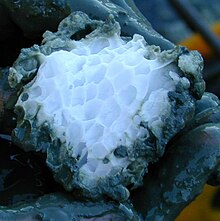
Clathrate hydrates, or gas hydrates, clathrates, or hydrates, are crystalline water-based solids physically resembling ice, in which small non-polar molecules (typically gases) or polar molecules with large hydrophobic moieties are trapped inside "cages" of hydrogen bonded, frozen water molecules.[1][2] In other words, clathrate hydrates are clathrate compounds in which the host molecule is water and the guest molecule is typically a gas or liquid. Without the support of the trapped molecules, the lattice structure of hydrate clathrates would collapse into conventional ice crystal structure or liquid water. Most low molecular weight gases, including O2, H2, N2, CO2, CH4, H2S, Ar, Kr, Xe, and Cl2 as well as some higher hydrocarbons and freons, will form hydrates at suitable temperatures and pressures. Clathrate hydrates are not officially chemical compounds, as the enclathrated guest molecules are never bonded to the lattice. The formation and decomposition of clathrate hydrates are first order phase transitions, not chemical reactions. Their detailed formation and decomposition mechanisms on a molecular level are still not well understood.[3][4][5] Clathrate hydrates were first documented in 1810 by Sir Humphry Davy who found that water was a primary component of what was earlier thought to be solidified chlorine.[6][7]
Clathrates have been found to occur naturally in large quantities. Around 6.4 trillion (6.4×1012) tonnes of methane is trapped in deposits of methane clathrate on the deep ocean floor.[8] Such deposits can be found on the Norwegian continental shelf in the northern headwall flank of the Storegga Slide. Clathrates can also exist as permafrost, as at the Mallik gas hydrate site in the Mackenzie Delta of northwestern Canadian Arctic. These natural gas hydrates are seen as a potentially vast energy resource and several countries have dedicated national programs to develop this energy resource.[9] Clathrate hydrate has also been of great interest as technology enabler for many applications like seawater desalination,[10] gas storage,[11] carbon dioxide capture & storage,[12] cooling medium for data centre[13] and district cooling etc. Hydrocarbon clathrates cause problems for the petroleum industry, because they can form inside gas pipelines, often resulting in obstructions. Deep sea deposition of carbon dioxide clathrate has been proposed as a method to remove this greenhouse gas from the atmosphere and control climate change. Clathrates are suspected to occur in large quantities on some outer planets, moons and trans-Neptunian objects, binding gas at fairly high temperatures.[14]
- ^ Englezos, Peter (1993). "Clathrate hydrates". Industrial & Engineering Chemistry Research. 32 (7): 1251–1274. doi:10.1021/ie00019a001.
- ^ Hassanpouryouzband, Aliakbar; Joonaki, Edris; Vasheghani Farahani, Mehrdad; Takeya, Satoshi; Ruppel, Carolyn; Yang, Jinhai; J. English, Niall; M. Schicks, Judith; Edlmann, Katriona; Mehrabian, Hadi; M. Aman, Zachary; Tohidi, Bahman (2020). "Gas hydrates in sustainable chemistry". Chemical Society Reviews. 49 (15): 5225–5309. Bibcode:2020CSRev..49.5225H. doi:10.1039/C8CS00989A. hdl:1912/26136. PMID 32567615. S2CID 219971360.
- ^ Gao S; House W; Chapman WG (2005). "NMR MRI Study of Gas Hydrate Mechanisms". The Journal of Physical Chemistry B. 109 (41): 19090–19093. CiteSeerX 10.1.1.175.9193. doi:10.1021/jp052071w. PMID 16853461. S2CID 18762205. Retrieved August 3, 2009.
- ^ Gao S; Chapman WG; House W (2005). "NMR and Viscosity Investigation of Clathrate Formation and Dissociation". Ind. Eng. Chem. Res. 44 (19): 7373–7379. doi:10.1021/ie050464b. Retrieved August 3, 2009.
- ^ Choudhary, Nilesh; Chakrabarty, Suman; Roy, Sudip; Kumar, Rajnish (January 2019). "A comparison of different water models for melting point calculation of methane hydrate using molecular dynamics simulations". Chemical Physics. 516: 6–14. Bibcode:2019CP....516....6C. doi:10.1016/j.chemphys.2018.08.036. S2CID 106222519.
- ^ Michael Faraday (1859). On Hydrate of Chlorine. Quarterly Journal of Science. pp. 81–84. Retrieved 8 April 2024.
- ^ Ellen Thomas (November 2004). "Clathrates: little known components of the global carbon cycle". Wesleyan University. Retrieved 13 December 2007.
- ^ Buffett, B.; Archer, D. (2004). "Global inventory of methane clathrate: sensitivity to changes in the deep ocean". Earth Planet. Sci. Lett. 227 (3–4): 185–199. Bibcode:2004E&PSL.227..185B. doi:10.1016/j.epsl.2004.09.005.
- ^ Chong, Zheng Rong; Yang, She Hern Bryan; Babu, Ponnivalavan; Linga, Praveen; Li, Xiao-Sen (2016). "Review of natural gas hydrates as an energy resource: Prospects and challenges". Applied Energy. 162: 1633–1652. Bibcode:2016ApEn..162.1633C. doi:10.1016/j.apenergy.2014.12.061.
- ^ "Drinkable water from cold energy | Engineers Australia".
- ^ "Eco-friendly ways to harness natural gas efficiently". The Straits Times. 30 June 2017.
- ^ Babu, Ponnivalavan; Linga, Praveen; Kumar, Rajnish; Englezos, Peter (1 June 2015). "A review of the hydrate based gas separation (HBGS) process for carbon dioxide pre-combustion capture". Energy. 85: 261–279. Bibcode:2015Ene....85..261B. doi:10.1016/j.energy.2015.03.103.
- ^ "NUS, Keppel, SLNG in tie-up to develop better cooling technology for data centres". The Straits Times. 22 October 2019.
- ^ Ghosh, Jyotirmoy; Methikkalam, Rabin Rajan J.; Bhuin, Radha Gobinda; Ragupathy, Gopi; Choudhary, Nilesh; Kumar, Rajnish; Pradeep, Thalappil (29 January 2019). "Clathrate hydrates in interstellar environment". Proceedings of the National Academy of Sciences. 116 (5): 1526–1531. Bibcode:2019PNAS..116.1526G. doi:10.1073/pnas.1814293116. PMC 6358667. PMID 30630945.